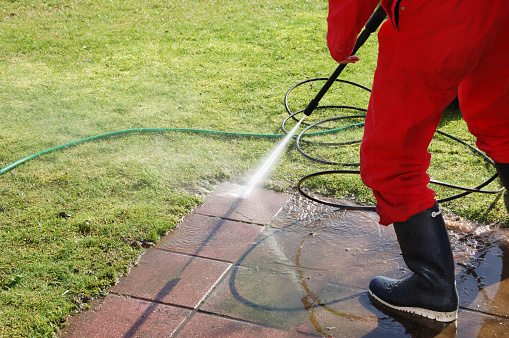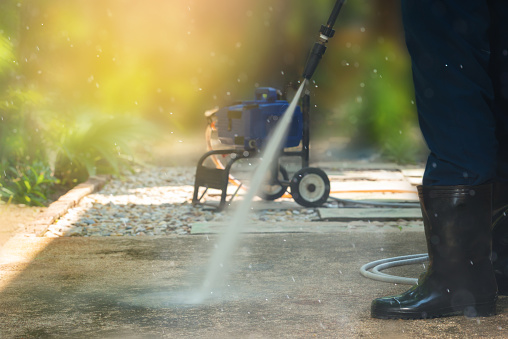Petrol pressure washers are awesome machines that make hard cleaning tasks such as shifting grime and oil stains from cars and driveways a piece of cake. If you’re looking to buy your first petrol pressure washer, or are just in the market for a new model, check out our best petrol pressure washers reviewed page. It’s full of in-depth reviews of the latest and greatest products.
Offering far more cleaning power than electric pressure washers, petrol powered models are often the go to for people who have large cleaning jobs to tackle, or who have to use their pressure washer on a regular basis. The flip side to this extra power though, is that you have to keep them properly maintained with regular services. Now, to get a professional in to do this could end up being costly, but actually there is really no need for the most part, and you can handle a lot of the maintenance yourself.
So, here is our guide to how to service a petrol pressure washer.
How often should I service my petrol pressure washer?
The answer to this isn’t as straightforward as you might like, I’m afraid. Different models will have different service schedules, but all should be based on how many hours you have used the petrol pressure washer.
Your machine should have come with its own servicing schedule, either as a separate document, or as part of the user’s manual. Failing this, you should be able to find it online. Not every service will involve a full rehaul of everything, and different components will need maintenance at different times. Some checks should be performed before every use, while others, such as replacing filters, only need to be done every couple of years or every couple of hundred hours of use, depending on which comes first.
Here’s a breakdown of what to expect:
Before each use
Every time you get out your petrol pressure washer you need to check for leaks. These leaks can occur due to a wide range of factors, so it’s important to make sure that your machine isn’t bleeding water, petrol, or oil.
You can check for oil and petrol leaks by inspecting the engine, pump, and frame of your pressure washer to see if there is an unusual abundance of residue or stains. There is bound to be a small amount of residue, that’s normal and easily wiped clean, but if there’s a lot, you should take it to get repaired. Messing around with fuel lines and engines isn’t something you should really tackle on your own I’m afraid.
To check that the washer isn’t leaking water, simply attach it as normal, then turn on the mains and look for any drips or leaks. If all is good, turn on the machine spray while going through the different power modes to see if leaking occurs.
You also need to check on the levels of your fuel and oil. How to do this will depend on your particular pressure washer, but most will have a dipstick located on the engine that you unscrew, clean off and then reinsert to get a reading, or maybe there will be some other feature that tells you how much fuel is in there.
The final thing you should do before using your petrol pressure washer is to clean out the air filter. Keeping this clean will prevent your engine being damaged by incoming debris, so it’s incredibly important to check it.
Cleaning it is very easy, simply remove it and then give it a few knocks against the floor to loosen any stuck-on dirt. After this, you just need to wipe it clean with a cloth or clean rag.
Changing engine oil
Just like a car or motorbike, your petrol pressure washer needs to have nice, clean, engine oil to keep all those moving parts lubricated and working properly. If you have just bought a new petrol pressure washer, you should perform your first oil change after the first few uses. Most manuals will suggest after 5 hours. Following this initial oil change, you shouldn’t have to perform this task again until you’ve put in at least 25 hours or so with the machine.
Changing oil is a relatively easy job that you can do yourself, and you just need a plastic container that is large enough to catch the old oil, and something to unscrew the drain bolt that will be located on the engine, You can look to your manual for the location of this.
Run the pressure washer for a while to get the oil heated up and then place the container under the drain bolt. Unscrew the bolt, and the oil should just run out. Once it’s empty, tighten the bolt back up, and then refill the oil through the appropriate inlet.
Clean the spark arrestor and spark plug
After a year of use, you need to check and clean both the spark arrestor and spark plug.
To remove the spark arrestor, you’ll need to locate the muffler protector and then remove the bolts holding this in. Underneath the muffler protector you will find the spark arrestor. Remove it and give it a good cleaning. Once it’s clean, inspect it carefully, looking out for any cracks or other damage. If there is a problem, it’ll need replacing.
To check the spark plug you need to locate it on your machine and then disconnect the cap. Remove the spark plug using a spanner and then wipe it clean. Once cleaned, check for wear and damage and replace if necessary.
After 2 years
After a couple of years of use, you should really change a few vital components: namely the air and fuel filters. These are pretty straightforward jobs that you should be able to do on your own without any complications.
 Fuel lines can wear down and get damaged over time just through regular use, so I would recommend changing this at the same time too, as well as giving the whole machine a very close inspection to see if anything as frayed, cracked, broken off, or if there are any rust spots.
Fuel lines can wear down and get damaged over time just through regular use, so I would recommend changing this at the same time too, as well as giving the whole machine a very close inspection to see if anything as frayed, cracked, broken off, or if there are any rust spots.
Storing your petrol pressure washer
Storing your petrol pressure washer properly is as important as checking it regularly.
Firstly, always make sure that the machine has been fully drained out of water and detergent, and dried out properly. Moisture can cause all sorts of problems while the pressure washer is in storage, so don’t overlook the drying process, and water can freeze in the winter if left in the detergent tank.
If you’re not going to be using the machine for a long time, it’s not a good idea to leave fuel in the engine, so drain it out properly. This entails draining it like you would when changing the oil, but also running it dry by switching the pressure washer on.
Finally, get a good dust cover for your machine while it sits in storage. Dust and other articles can get settled into the tiny gaps in your pressure washer and cause wear and damage. Good covers are easy to come by, and won’t break the bank.
